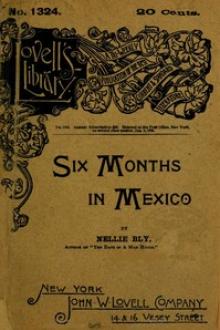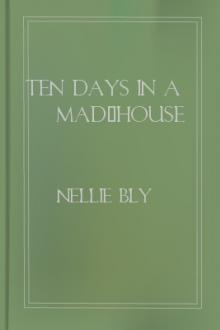Six Months in Mexico by Nellie Bly (best classic literature TXT) 📕

- Author: Nellie Bly
- Performer: -
Book online «Six Months in Mexico by Nellie Bly (best classic literature TXT) 📕». Author Nellie Bly
Leaping a ditch we left the highway and traveled through the fields, stopping to gather a few pepper berries with which to decorate ourselves, admiring the many-colored birds flitting from tree to tree. Another ditch, which the horses cleared beautifully, was left behind and we were once again on a highway, with dust about a foot deep, which made horses cough as well as their riders. “This is bad,” one of the gentlemen managed to say at last. We were only able to give a sympathetic grunt and then had to gasp fifteen minutes before we could regain our breath. “There is a hacienda near where we will get a drink and change roads. Vamos.” Off we went, leaving the dust behind, and were soon in the shaded drive leading to the hacienda.
Here, at Huischal, we soon forgot the scorching sun and blinding dust and gave ourselves up to the pleasure of the moment, watching the ever picturesque people gathered in groups beneath the shade. Under the trees were droves of horses, which were taken two by two, and led into a large walled pond. A peon walked on the wall, holding the bridle of the tethered horses, who swam from one end to the other, covered all but the head. After the bath the horses were rubbed well until they glistened like satin.
Climbing the hill we passed all kinds of Indians and huts. There were homes built entirely of the maguey plant, where straw mats served for beds. The people were all awake and engaged in various occupations; some women were washing, some were making their toilet - combing their hair with the same kind of brush they scrub with, and washing their bodies with a porous soapstone common to the country. Very few of the children had any clothing at all, but happiness reigned supreme. We passed several plain wooden crosses with inscriptions on them, asking travelers to pray for the deceased’s soul. It brought forcibly to mind Byron’s “Childe Harold.”
Quite on the top of the hill, and facing Chapultepec, gleams a marble monument erected in honor of the Mexicans killed while defending Casa de Mata (the house of the dead) and El Molino del Rey (the mill of the king). The Americans discovered, while encamped near here, that cannon, etc., were being manufactured at El Molino, so they decided to storm the place; they found the work more difficult than they expected. The Mexicans were fighting for a country they loved, and for which they had been compelled to fight for generations. Their walls were strong, but at last they gave way before the heavy artillery of the Americans, and their dead covered the battlefield. Casa de Mata is now a garrison, and the soldiers march back and forth with sad faces. El Molino del Rey now furnishes flour for the city. It shows no trace of the assault. Near by is a foundry for the manufacture of guns and munitions.
The city of the dead, Dolores, lies to the back of the mill. Funeral cars and draped street cars were just returning from the cemetery, and as the people are not allowed to ride or drive along this carway, we crossed into a plantation of pulque plant. It is a resentful thing, and a whole army in itself. It ran its sharp prongs into the legs of the men, endeavored to pull the skirts off the women, and played spurs on the horses; but we finally emerged at the entrance of the cemetery, alive, but wiser from our experience.
Mexican cemeteries have a certain peculiar beauty, and yet they are ugly. No one is allowed to ride or drive through; coffins are carried in and everybody is compelled to walk. Beautiful trees are cultivated, even the apple and the peach being reared for ornament. The walks are laid out nicely. Spruce trees are trained to form an arbor for long distances. Where they are divided or meet another walk, flowing fountains with large basins and statues grace the spot. One statue, which looked rather singular, was apparently carved out of wood. It represented a man with flowing locks and beard, clad in a long gown and holding in one hand a round ball. Time had its hand on heavily, and the wood was seamed and browned. Altogether it was a disreputable-looking thing. The keeper said it represented Christ with the world in his hand. Not a sprig of grass is permitted to grow in any of the graveyards, and they are swept as clean as our grandmother’s backyard used to be.
Men were busy digging graves, and new ones were completely hidden by fresh flowers, and the flowers on others were withered and dead, as if the one so lately buried was already forgotten. The monuments are quite fine. Some have little altars on which candles are lighted on certain days. The prevailing style of marble shaft is coffin shaped. Some graves have miniature summerhouses built over them, the framework covered with Spanish moss. The effect is beautiful. The poor have only black and white wooden crosses to mark their ashes. One family had built a cave, formed of volcanic stone, over the grave, the effect being quite pretty and unique.
After partaking of refreshments at a long, low building, just outside the cemetery gate, we rode across the country and into Tacubaya, an ancient city once the home of Montezuma’s favorite chief, where the American soldiers were encamped, now the home of Mexican millionaires, the site of the feast of the gamblers, and the prettiest village in Mexico. The gambling feast has ended and the town has been restored to its usual quietness. In the center plaza a band was holding forth, as is the custom in every Mexican village on Sunday mornings. People had gathered in sun and shade listening. The markets were in full blast; the thousands of luscious fruits looking fresh and inviting as they were spread on the ground awaiting buyers. The native ware was so peculiar and the “merchant” - half-dressed, brown and pleasant - was more than we could resist, so buying two small cream jugs, made after the style in vogue fifty years ago, we paid him two reales (fifty cents) and departed, leaving him happy.
Once again the willing horses climbed the hill, and reaching the summit we inspected the waterworks which have so faithfully supplied the city for years. A weather-beaten frame house hid the well or spring that has given such a generous supply. A wooden wheel as large as the house itself, moved slowly, as if age and rheumatism had stiffened its joints. The water flowed gently through an open trench into another building, whence it rushed, white, foaming and sparkling, into the ground, leaving only high brick air-pipes to mark its course to the aqueduct.
By the side of the trench a woman was doing her washing, and two little lads, with poles across their shoulders and buckets suspended from either end, were carrying water to the houses down in the valley. An old cow with curly horns gazed at us in astonishment as we invaded her private meadow to get a view of a paper mill, which is built in the shape of an old English castle, down in a deep ravine in a nest of lovely green trees. The old cow had evidently come to the conclusion, after deliberate reasoning, that we were intruding, and she charged our horses in a first-class “toro” style. There were no capeadores to attract her attention, no bourladeras for us to hide behind, so we thought it best to fly, which we did with a Maud S speed. I did not mention I had lost my hat in the retreat until we were over the trench, and one of the young men gallantly started to recover it, against the protestations of the entire crowd. We expected to see him killed, but the cow stood watching him as he dismounted for the feminine headgear, gesticulating with head and tail and beating the earth with her fore legs. Remounting, he saluted her, then putting spurs to his horse he cleared the ditch, leaving the baffled and angry cow on the other side.
La Castaneda, the great pleasure-garden of the Mexicans, was next visited. Beautiful flowers, shrubbery and marble statues grace the well-kept resort. Neat little benches, cunning little vine-draped nooks, sprinkling-fountains, secluded dancing-stands, deep bathing-basins, are a few of the many attractions. Shaded walks and twisting stairways would always bring us to some new beauty. Music and dancing are always held here every afternoon, and although it was nearly noon they had not even so much as a cracker in the house. In Mexico nothing in the line of edibles is kept in the house overnight.
At Mixcoac we visited the famous flower gardens, and viewed the site where the American soldiers were garrisoned during the war. The Mexicans have found a new thing - a pun, and they are enjoying it heartily. It is not very brilliant or very funny, but it is traveling over the city, and every person has to repeat it to you. An American wanted to see Mixcoac - pronounced “Mis-quack.” The conductor failed to let him out at the place, and turning to the Mexicans he said: “We have mis-t-quack.” But it was funnier still to an American who was being showed around by a Mexican who spoke very little English. “I will take you to see Mis-quack,” said the Mexican. The American expressed his pleasure and willingness. “This is all Mis-quack,” said the Mexican, pointing around the entire town. “Indeed,” ejaculated the astonished tourist; “Miss Quack must be very wealthy.”
Down the dusty road we came, passing natives shooting the pretty birds just for the fun of the thing. All other riders had disappeared, and people looked at us from beneath the shade in amazement, and even





Comments (0)